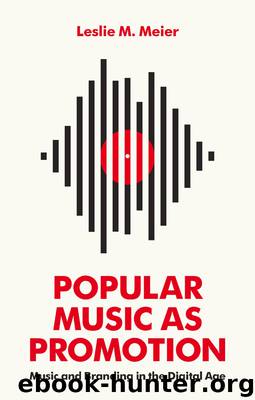Popular Music As Promotion by Meier Leslie M.;

Author:Meier, Leslie M.;
Language: eng
Format: epub
Publisher: Polity Press
Published: 2017-01-02T05:00:00+00:00
Brand Partnerships and ‘Content Curation’ Strategies
The proliferation of music placements has had a curious effect: from the perspective of advertisers, the use of popular music in and of itself no longer achieves the objective of brand differentiation, yet music remains a rich source of cultural meaning and, hence, value to brands. While ‘music is not unique anymore as far as breaking … through the cluttered marketplace’, one advertiser explained, it remains ‘a way for brands to help touch different cultures’ (lifestyle advertising account executive, personal communication, 2011). Tunnicliffe uses the term ‘brand–music partnerships’ to describe a more recently introduced set of strategies and business partnerships that bring together music and marketing (Tunnicliffe, personal communication, 2010). ‘Brand/music partnerships truly [came] of age in 2008, with a raft of increasingly innovative deals between brands and musicians appearing on what seems like a daily basis’, according to Tunnicliffe. ‘A number of brands [are] striking deals that go way beyond traditional music licensing for TV commercials or standard endorsement deals’ (Tunnicliffe 2008). While these business partnerships do not follow a set template, they are underpinned by a common logic: the creation of targeted, strategically paired and therefore seemingly ‘credible’ matches between consumer brands and ‘artist-brands’. In the ‘brand–music partnership’ era (c.2008–present), we have seen increasing use of ‘authentic’ popular music and novel business arrangements as a result of strategies designed to grab attention, ‘touch’ audiences and build value for brands.
The foundation of brand–music partnerships remains brands' interest in mining the associations tied to popular music and recording artists in order to reinforce brand identities and build brand equity. However, as advertisers have detected consumer resistance to blatant commercialism, the particular associations sought have changed. In the words of Steve Stoute, CEO of advertising agency Translation, ‘The biggest mistake is that they [brand marketers] try to bring the artist into the brand's culture and what they really need to do is get their brand into the artist's culture’ (quoted in High 2009). According to a strategist at a New York City-based advertising firm, ‘Brands are trying to be more lifestyle oriented. … They're trying to step away from being super commercial. … They're trying to feel more authentic. They're trying to feel like they're a part of your life. … That's the kind of emotion they want to evoke in you’ (advertising strategist, personal communication, 2011; see also Holt 2002: 83–5). As music supervisor David Hayman observes, ‘gone are the days of jingle houses. … [M]ore and more these days the brands want a song that actually really exists that they can reference in the real world, so it's “authenticity” ’ (Hayman, personal communication, 2009). Under contemporary marketing strategies, brands ‘use’ recording artists to ‘talk to’ fans, but ‘in a subtle way’ (Tunnicliffe, personal communication, 2010).
From the perspective of advertisers and brands, popular music can lend brands authenticity (Hayman, personal communication, 2009; Tunnicliffe, personal communication, 2010; advertising strategist, personal communication, 2011; Gutstadt, personal communication, 2011; lifestyle advertising account executive, personal communication, 2011; White, personal communication, 2011).
Download
This site does not store any files on its server. We only index and link to content provided by other sites. Please contact the content providers to delete copyright contents if any and email us, we'll remove relevant links or contents immediately.
| Anthropology | Archaeology |
| Philosophy | Politics & Government |
| Social Sciences | Sociology |
| Women's Studies |
Cecilia; Or, Memoirs of an Heiress — Volume 1 by Fanny Burney(32078)
Cecilia; Or, Memoirs of an Heiress — Volume 3 by Fanny Burney(31471)
Cecilia; Or, Memoirs of an Heiress — Volume 2 by Fanny Burney(31420)
The Great Music City by Andrea Baker(30797)
We're Going to Need More Wine by Gabrielle Union(18646)
All the Missing Girls by Megan Miranda(14801)
Pimp by Iceberg Slim(13806)
Bombshells: Glamour Girls of a Lifetime by Sullivan Steve(13701)
Fifty Shades Freed by E L James(12928)
Talking to Strangers by Malcolm Gladwell(12891)
Norse Mythology by Gaiman Neil(12863)
For the Love of Europe by Rick Steves(11573)
Crazy Rich Asians by Kevin Kwan(8902)
Mindhunter: Inside the FBI's Elite Serial Crime Unit by John E. Douglas & Mark Olshaker(8726)
The Lost Art of Listening by Michael P. Nichols(7170)
Enlightenment Now: The Case for Reason, Science, Humanism, and Progress by Steven Pinker(6883)
The Four Agreements by Don Miguel Ruiz(6329)
Bad Blood by John Carreyrou(6286)
Weapons of Math Destruction by Cathy O'Neil(5853)
